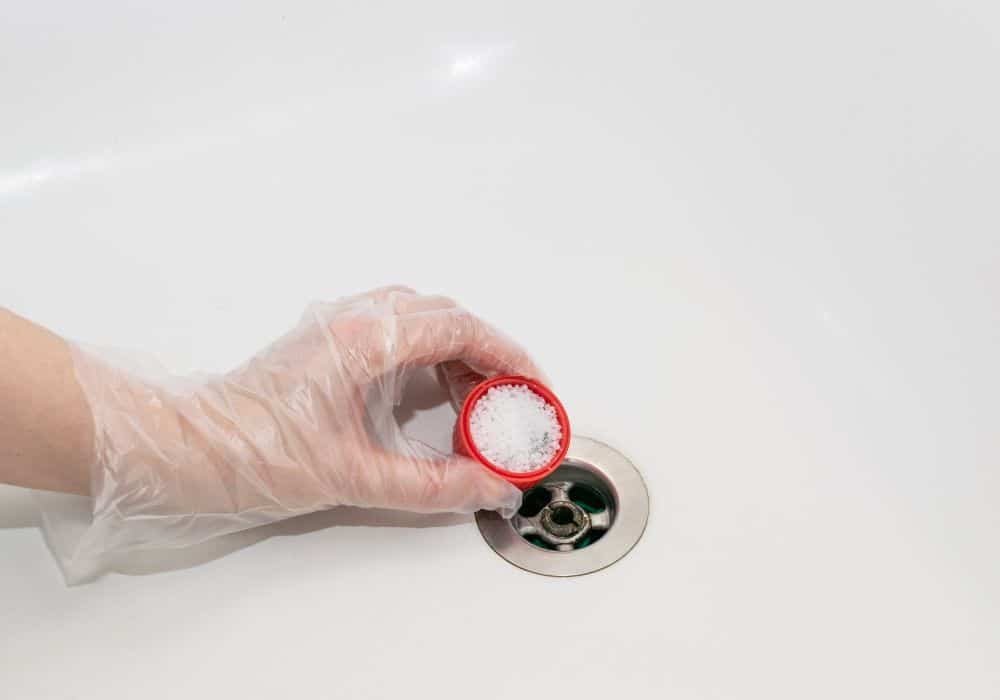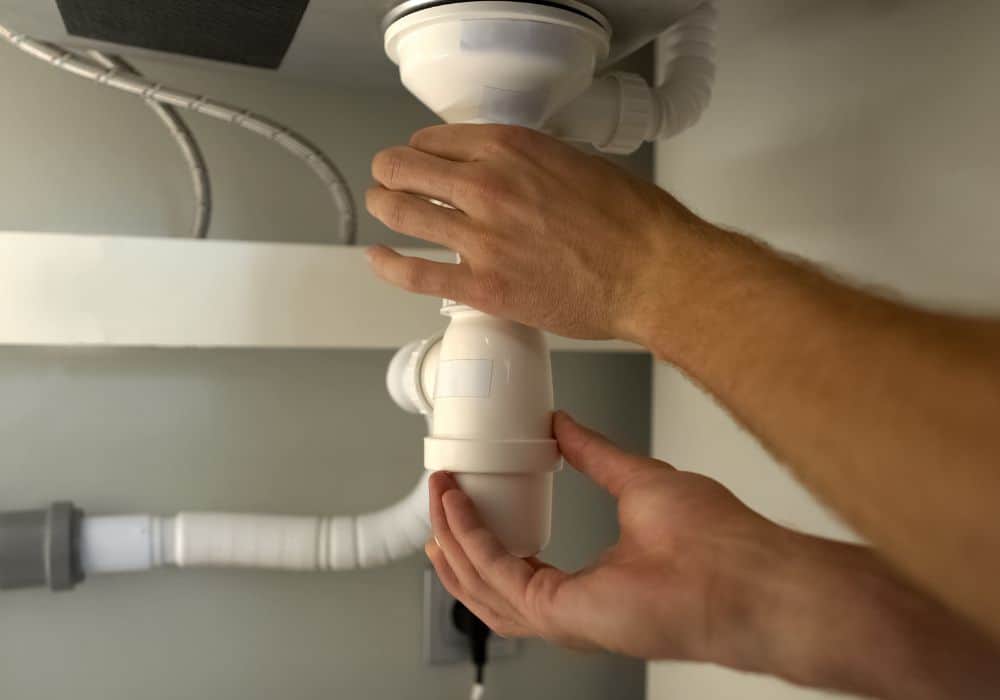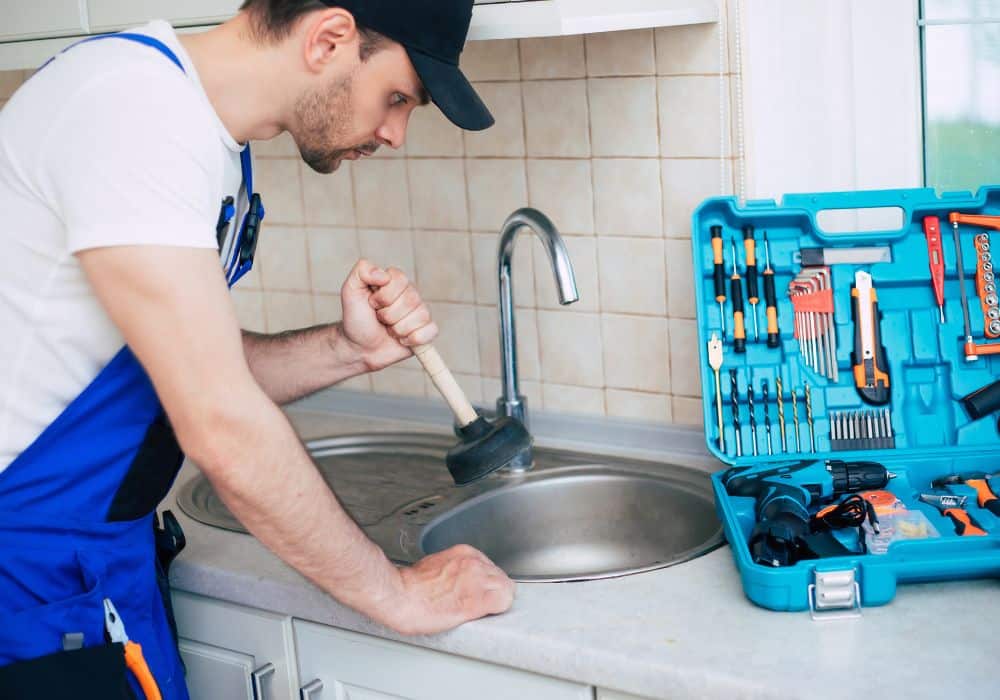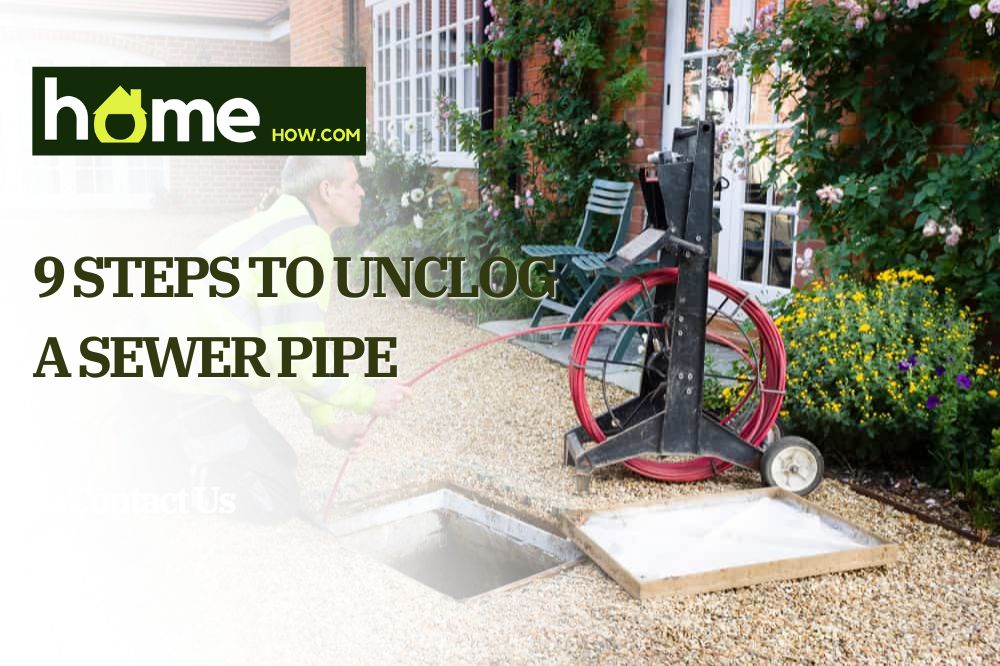Are you looking for an easy way to flush out your clogged sewer line?
The good news is you can do this without the help of plumbers. All you need are some household items, as you’ll see below.
Without further ado, here’s how to unclog a sewer pipe – without calling in the professionals!
Tools Needed
- Rubber gloves for all methods
- Boiling water method: boiling water
- Bent wire hanger method: wire hanger, boiling water
- Vinegar and baking soda method: vinegar, baking soda, boiling water
- Baking soda, vinegar, and water pressure: baking soda, vinegar, water, bucket, plunger or auger
- Salt and baking soda method: salt, baking soda, boiling water
- Caustic soda method: goggles, caustic soda, water, bucket, boiling water
- Wet and dry vacuum method: vacuum
- Dish detergent method: dish detergent, boiling water, plunger
- Sink pipe cleaning: bucket, wrench, brush and/or toothbrush, boiling water
For main sewer drain cleaning:
- Work gloves
- Pipe wrench
- Plumbing snake or auger (may be rented from hardware stores)
- Garden hose
How to Remove Sewage Pipe Blockages
If a certain drain in your home won’t clear out (or doesn’t clear out easily,) then it may be plugged up. The good news is you can unclog it in a variety of ways:
1. Boiling Water Method
Boiling water can help ‘melt’ the debris that’s blocking your drain line. It’s quite easy to do too, as it only takes two steps.
- Boil as much water as you can in a kettle.
- Pour boiling water into the drain pipe in an intermittent fashion.
2. Bent Wire Hanger Method
Here’s how to unclog your drain with just one item – a bent wire hanger.
- Straighten a wire hanger and create a hook on one side.
- Insert the hooked end in the clogged drain.
- Remove all the debris that’s clogging your tub or shower. Be careful when doing this as you don’t want to push the blockages down the pipes.
- Pour hot water into the drain.
3. Vinegar and Baking Soda Method
Baking soda is a mild alkali that can dissolve dirt. Acidic vinegar, on the other hand, can help dissolve grease and hair. It also neutralizes odor molecules, thus helping ‘deodorize’ bathroom sinks and other drain lines.
To remove the blockages with these ingredients, you need to:
- Mix 1/3 cup of baking soda with 1/3 cup of vinegar.
- Pour the mixture into the blocked-up drain. Leave it for an hour.
- Pour hot water into the newly-unclogged drain.
4. Baking Soda, Vinegar, + Water Pressure
The addition of water flow/pressure to the two items above can help unclog a bath drain easily. Here’s how to do it:
- Mix 1 part baking soda and 2 parts vinegar. Add the mixture to 60 gallons of water.
- Pour the mixture into the drain. Use a plunger or auger as you do so to remove the blockages.

5. Salt and Baking Soda Method
A combination of salt and baking soda makes for an easy sewer cleanout. Here’s how to use it for your clogged pipes:
- Mix 1 part salt with 2 parts baking soda.
- Pour the mixture into the drain. Leave it for a couple of hours.
- Flush the drain with boiling water.
6. Caustic Soda Method
Also known as sodium hydroxide or lye, caustic soda is an alkaline agent that can dissolve animal and vegetable tissue. As such, it’s pretty effective in unclogging kitchen drains.
When using caustic soda, you need to:
- Wear gloves and goggles. Caustic soda can cause burns!
- Mix 3 cups of caustic soda and 15 liters of water in a bucket. Stir the mixture until it fizzes.
- Pour the mixture into the drain line. Leave it for 30 minutes.
- Flush the drain with boiling water.
7. Wet and Dry Vacuum Method
A vacuum cleaner is not only good for keeping your basement floors spotless. You can also use it to fix your clogged drain pipes.
Here’s how to do it:
- Cover the vent.
- Place a tight seal over the affected drain line.
- Adjust the vacuum settings to ‘liquids.’
- Turn the machine on and let it ‘pull’ the blockages into the vacuum bag.
Pro tip: for best results, do the bent wire hanger method first before proceeding with this unclogging hack.
8. Dish Detergent Method
Your toilet bowl can get clogged with toilet paper, feminine hygiene products, and paper towels, to name a few. The good news is you can get rid of them with the help of two household items.
The first is dish detergent, which can help lubricate the blockages. The second is boiling water, which can readily dissolve them.
Here’s how to use these two ingredients for your clogged toilet bowl:
- Pour 1/4 cup of dish detergent, followed by boiling water, into the toilet bowl.
- Use a plunger to get rid of the debris. Add more boiling water as needed.

9. Sink Pipe Cleaning
If your kitchen or bathroom sink isn’t draining well (or as quickly as it should), then you may have a blocked flex pipe. To clear this up, you need to:
- Place a bucket underneath the flex pipe. This will help catch all the sewage or blockage trapped in the pipe.
- Use a wrench to remove the flex pipe nuts. Uninstall the U-shaped pipe.
- Remove the debris in the system. You may use a toothbrush to get rid of the small stuck remnants.
- Re-attach the flex pipe.
- Flush the pipe with hot water.
How to Clear a Main Sewer Line Clog
If your drains continue to be backed up despite following the steps above, then you may have a problem with your main sewer pipe.
Here’s how to unplug it like a pro:
Step 1. Open the Drain Pipe Cap
Use a wrench to loosen the drain pipe. Open it, but make sure that you get out of the way quickly. This action will lead to the spill-out of debris from the system.
Make sure all the blockages have flowed out before you proceed to the next step.
Step 2. Insert the Plumbing Snake Into the Drain Pipe
Generally speaking, you need to insert the auger until you feel resistance. If you find it harder to snake in the auger, it means you’ve reached the clogged part.
Pro tip: Read the auger manufacturer’s instructions carefully. Although most models are used the same way, yours might require certain steps/nuances to function. If you find it hard to follow the brochure, you can also refer to this video on how to use a sewer snake.
Step 3. Let the Auger Run
Run the auger machine until you clear the clog. You know you’ve managed to do this when the water level has decreased and drained out.
Pro tip: you shouldn’t stop the snake right away even if the water level has changed. Let the auger machine run a little more to remove the small clogs in your drain line.
Step 4. Hose the Pipe and Auger Down
After removing the clog, open the water line and put it at full blast. Use your hose to clean the pipe and auger simultaneously. This will help get rid of the debris that may be stuck on the pipe or snake.
Step 5. Remove the Plumbing Snake
Slowly retract the auger. Hose it off as you slowly remove it from the drain line. For best results, rinse the snake a few times before you place it back into the machine.
Re-cap the drain pipe and tighten it once again with a wrench.

FAQs
What are the signs that your sewer line is blocked?
- Slow drain
- Nasty odors
- Frequent clogging
- Sewage/water backing up (for example, if you flush the toilet, the bathtub suddenly fills with water)
- Rising/falling toilet bowl water level
- Unusual noises
- Water spilling from the cleanout
- Yellow/brown patches on the lawn
- Exposed tree roots
What causes sewer line clogging?
- Flushing debris down the sink or toilet
Coffee grounds, facial tissues, and eggshells, among many other things, can block the sewer line.
- Sagging sewage lines
Soil issues can cause the pipes to sag. Unfortunately, gravity will cause debris to collect and plug the sunken pipes.
- Pipe damage
Heavy above-ground traffic or the use of machinery can lead to pipe damage. A dented pipe won’t drain as effectively as a ‘good’ one.
Likewise, corroded metal pipes won’t function as well as they normally do.
These issues call for a replacement, which is something you can do on your own as well.
- Tree root infiltration
If your pipes are made of clay, tree roots can latch onto them and eventually penetrate them. The bad news is you won’t be able to solve this problem with any of the methods above. For this issue, you may need to call in the professionals.
Conclusion
You can unclog your sewer pipe in several ways. You can use:
- Boiling water
- Bent wire hanger
- Vinegar or salt and baking soda
- Caustic soda
- Vacuum cleaner
- Dish detergent
When it comes to unblocking the main sewer pipe, you will need to:
- Open the drain pipe
- Insert the snake
- Run the auger machine
- Hose the pipe and auger
- Remove the snake and re-cap the drain pipe
As you see, you don’t need a pro to unclog your sewer pipe. But if you need further assistance doing it yourself, don’t hesitate to ask your questions below.
